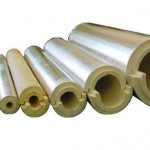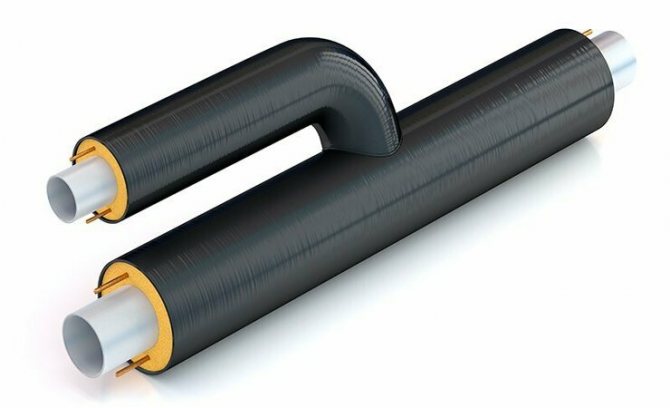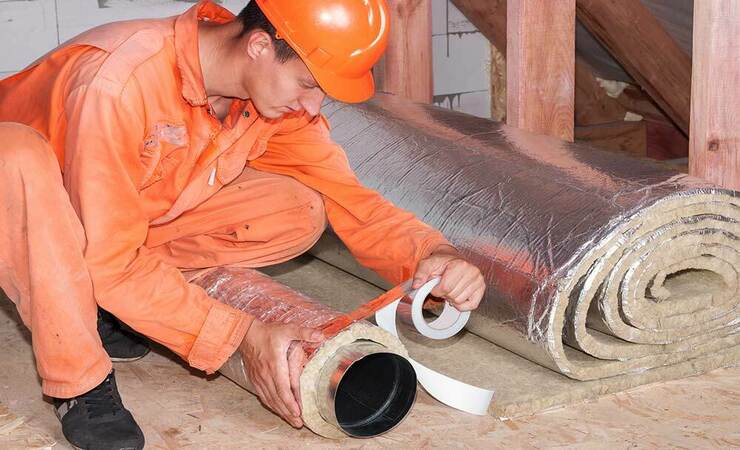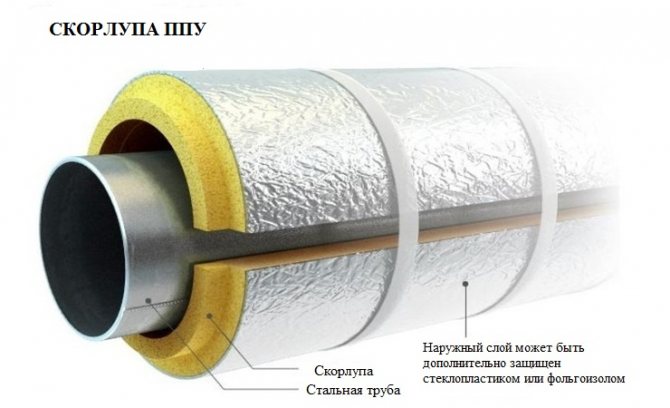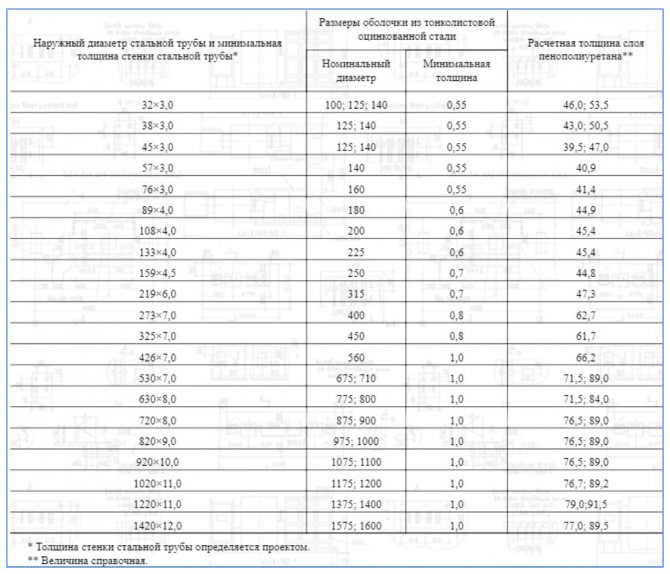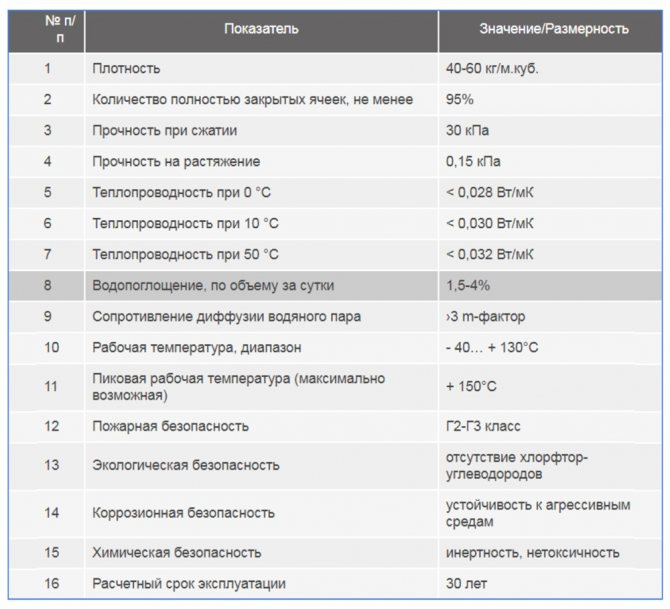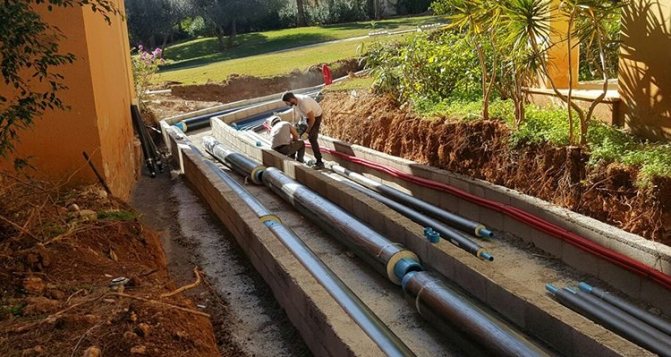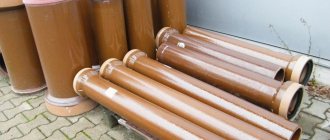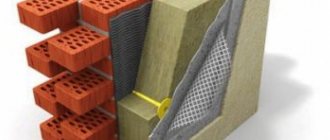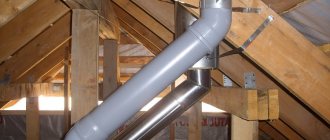Necessary properties and requirements for the shell for pipe insulation

Insulation shell with a lock for fastening on a pipe
The shell for pipes is a cylinder, notched on one side, or segments that are fastened together according to the groove-comb principle. Insulation without grooves can be fixed with clamps, wire, glue. After fixing, a protective casing is formed on the pipe surface.
Shaped elements are provided for insulating tees, branches, bends, abutment angles. To connect the shell along the length, use a separate shaped element - a sleeve.
Such communication protection does not insulate, but avoids heat dissipation or heating due to high ambient temperatures.
The shell must correspond to the diameter of the pipeline on which it will be mounted. The material from which the insulation is made must be resistant to low and high temperatures.
Basic requirements for thermal insulation for pipes:
- long service life;
- easy installation;
- insignificant thermal conductivity;
- resistance to mechanical stress;
- protection against burns in case of accidental touch;
- biological and chemical passivity;
- the ability to maintain a constant coolant temperature.
Different materials have different characteristics from each other. Taking into account the conditions in which the insulation will be installed, it is possible to choose a shell for pipes with suitable parameters.
Description and purpose
The shell for pipes got its name for the type and method of use. In fact, this is another pipe made of a certain material, which is put on a water pipe (or sewer, or heating, and so on).


This type of insulation performs several tasks at once:
- Prevents direct sunlight (if pipelines are laid in an open area). Prevents direct contact of the outer surface of the pipe with moisture, as well as various liquids and vapors. Reduces heat losses of the medium passing through the pipe (important for industry and hot water pipelines) and heating) Prevents human contact with hot surfaces Prevents freezing of the environment.
It can be used for insulation of pipelines with any medium.
Insulating materials for the manufacture of shells


The shell material is selected depending on the operating conditions of the pipes
The range of modern insulating materials fully complies with the listed requirements. Shells for pipe insulation are made of the following materials:
- polyurethane foam;
- expanded polystyrene;
- basalt insulation;
- foamed polyethylene;
- synthetic rubber.
Insulation is insulated in order to protect against mechanical damage and increase the efficiency of insulation:
- foil;
- fiberglass and fiberglass;
- galvanized and stainless steel.
Polyurethane foam
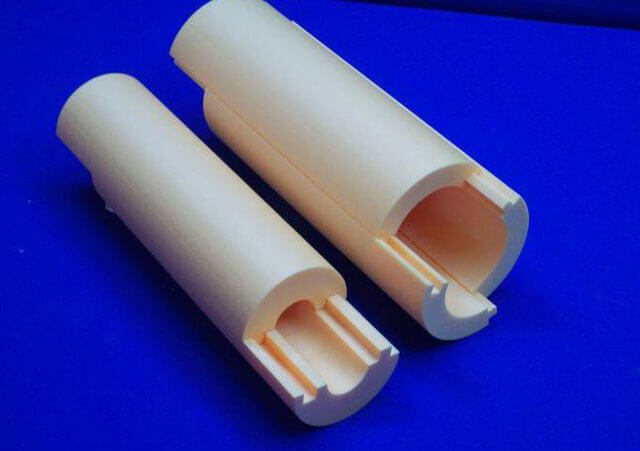

Polyurethane foam does not absorb water, therefore it is used for underground utilities
Polyurethane foam is a material with a fine-bubble closed-cell structure. It contains approximately 95% closed cells. PPU shell for pipes has the following technical characteristics:
- low thermal conductivity (0.037-0.042 W / m2 * K);
- high density (40-60 kg / m3);
- does not absorb water (1.5-3%);
- operating temperature range: -180 ° C to + 130 ° C.
Before installing the PPU shell for pipe insulation, the steel pipeline must be treated with anti-corrosion compounds, because the condensate formed due to the temperature difference remains under the shell and causes corrosion.
Fixation with the help of additional elements leads to the formation of seams, due to the presence of which heat loss increases. In order to seamlessly join the segments, polyurethane glue is used; it is recommended to fill the free space with polyurethane foam.
Expanded polystyrene


Styrofoam cannot be used without isolation from sunlight
A polystyrene foam shell is used mainly for insulating ventilation, water supply, sewer pipelines located in the ground, since the material has low resistance to ultraviolet radiation. It causes destruction of the structure. When insulating above-ground communications, it is necessary to wrap the shell or paint with something.
Benefits:
- does not absorb moisture;
- shows resistance to biochemical effects;
- withstands significant static load.
Disadvantages of Styrofoam:
- fire hazardous;
- not resistant to mechanical stress.
The working temperature range of expanded polystyrene is from -50 ° C to + 80 ° C.
Basalt insulation


Basalt wool is not used for insulating pipes located in the ground
It is recommended to use basalt shells for insulation of the external pipeline. Its main disadvantage is high water absorption, which cannot be compensated even with the help of hydrophobic impregnations. Once wet, the shell completely loses its thermal insulation properties. Operating temperature range: -40 ° C to + 74 ° C.
Benefits:
- light weight;
- Fire safety;
- resistance to ultraviolet radiation;
- environmental friendliness;
- biological resistance.
Disadvantages: used only for insulation of plastic pipes.
It is recommended to glue the seams of the basalt wool shell with reinforced tape or construction tape, and then paint.
Foamed polyethylene
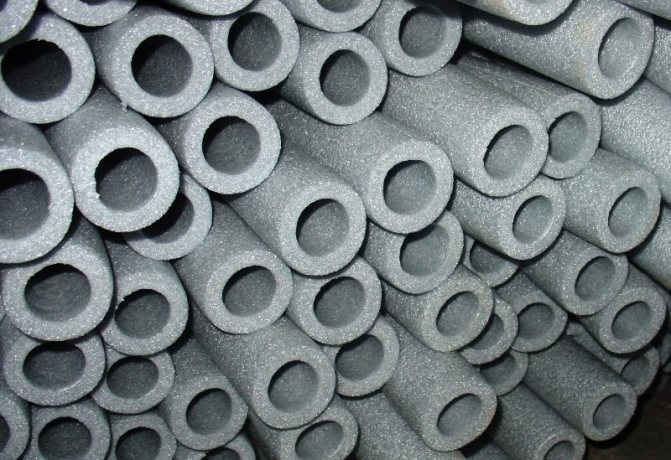

Foamed polyethylene does not absorb moisture
The polyethylene foam shell is a flexible and lightweight material in the form of a cylinder 1.2 or 2 m long with a slot. The operating temperature range varies from -40 ° C to + 95 ° C. Due to the special plasticity of the material, it is recommended to fix it with plastic or metal tightening clamps.
Benefits:
- relatively low price;
- has the properties of a steam, noise and heat insulator;
- resistance to aggressive environment;
- protects against the development of corrosion;
- environmental friendliness.
Disadvantages: Absorbs moisture.
Due to the high degree of water absorption, it is necessary to waterproof the shell from foamed polyethylene.
Synthetic rubber
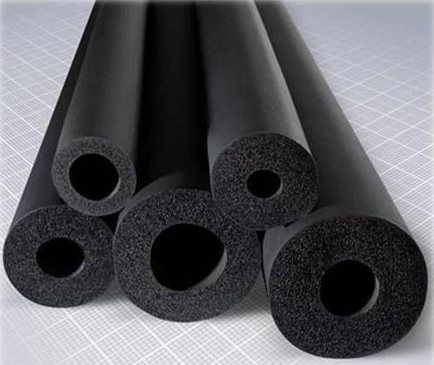

Synthetic rubber is not afraid of moisture and ultraviolet radiation, suitable for any communications
Synthetic rubber is superior to many materials in its performance characteristics. The insulating shell made of this material is produced in the form of cylinders with a longitudinal section, which can be mounted by putting the casing on the pipeline and gluing along the cut.
Benefits:
- UV resistance;
- resistance to aggressive environments;
- the minimum level of water absorption;
- effective insulation;
- vapor tightness;
- long service life;
- resistance to mechanical stress.
In order to improve its appearance, the insulation is painted with paint.
Technical characteristics of PPU shells:
Density, kg / m3 ……………………………………………………………………………………… .45-60 Thermal conductivity coefficient, W / m2 єС …… ………………………………………… 0.022-0.029 Compressive strength at 10% linear deformation, not less (MPa) ... ..0.20 Ultimate bending strength, not less, MPa …… …………………………………… .0.12 Application temperature, С ………………………………………………… ..from -180 to +130
A wide range of manufactured pipe shells provides our customers with the selection of PU foam insulation for any operating conditions with an optimal price-quality ratio. Insulation of pipes indoors, thermal insulation of pipelines in the open air or in underground laying is not a problem! Polyurethane foam insulation today is the most effective insulation for pipes, due to its low thermal conductivity, moisture resistance and combination of strength with chemical resistance throughout the entire life of the insulation, which exceeds the service life of the insulated pipeline!
We will select the necessary insulation and make it for you as soon as possible!
Range of PU foam insulation:
- uncoated polyurethane foam shells
- foil PPU shell
- shells PPU Armofol
- shell PPU fiberglass
- shell PPU galvanized
- PPU boards (sheet PPU)
Dimensions and diameters
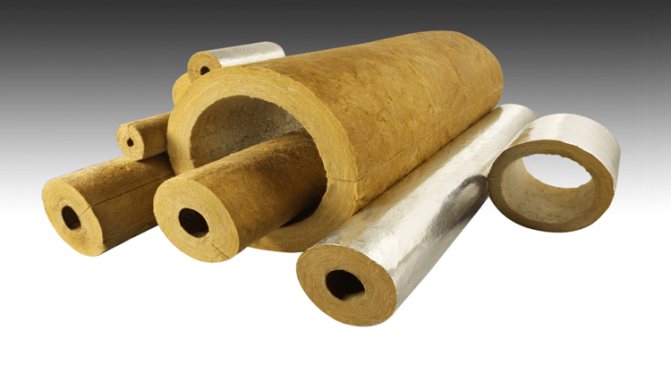

The size and thickness of the insulation layer is selected depending on the operating conditions
The shell is used for thermal insulation of aboveground and underground utilities. The protective cover is formed from two or more segments connected to each other. The larger the shell diameter, the more segments. The shell of a soft and flexible material, such as polyethylene foam, can be made in the form of a cylinder with a longitudinal cut. Shells of relatively dense material for small pipe diameters up to 2 inches are composed of semi-cylindrical segments. If the pipe diameter is 2 to 3 inches, the segments are narrower than 3. For larger diameter pipes, shells consisting of quarter-circle segments are suitable.
The inside diameter of the shell must match the outside diameter of the pipe.
The thickness of the insulation from which the shell is made varies from 9 to 90 mm. Insulation with a larger diameter and thickness will cost more. According to this parameter, the shell is selected taking into account the requirements for the effectiveness of thermal insulation.
Lengthwise dimensions also range from 1 to 2 m. The latter characteristic is determined by the ease of transportation, manufacture and installation.
1.3Polyurethane foam shell
Thermal insulation shell made of polyurethane foam (abbreviated as "PPU") is currently the most promising thermal insulation system of all available. Among its advantages, it should be noted such as:
- Minimum moisture absorption, as well as vapor permeability, which is ensured due to the special structure of the material consisting of closed cells; The thermal conductivity coefficient of polyurethane foam is an order of magnitude lower than that of the closest analogs and K-Flex thermal insulation for pipes; Operating temperature for polyurethane foam shells has impressive indicators: from - 180 and up to +130 degrees Celsius, which allows this material to be used, including for large industrial structures.
Advantages of shells for pipe insulation
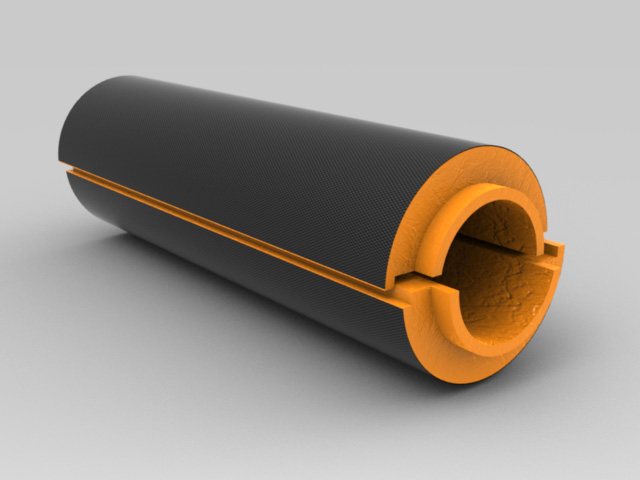

PPU shell is easily mounted, is not afraid of high and low temperatures, but needs shelter from ultraviolet radiation
Polyurethane foam shell is most suitable for pipe insulation. This insulation has a number of advantages:
- multiple use;
- resistance to mechanical, biological, chemical, atmospheric influences due to high density and chemical composition, including resistance to rodents and pests;
- durability;
- easy and quick installation at any temperature;
- possibility of installation without the use of additional fasteners;
- environmental friendliness;
- quick dismantling, if necessary, to repair a section of the pipeline;
- use in the insulation of underground and aboveground communications;
- does not make the structure heavier;
- shows inertness to fungi and mold;
- light weight;
- insignificant coefficient of thermal conductivity;
- soundproofing properties.
At a pipeline temperature above + 150 ° C, the insulation cokes.In addition, it collapses under the influence of ultraviolet rays, therefore, a prerequisite for warming overhead communications is the presence of a protective coating.
Advantages of PPU shells:
- high efficiency of thermal insulation due to a very low coefficient of thermal conductivity (0.022-0.029 W / m * K)
- reduction of heat energy losses in pipelines by 3-4 times in comparison with the normative ones;
- low labor intensity of work on pipe insulation, reducing the time of installation of thermal insulation by 5-6 times!
- durability (service life is more than 50 years!), the possibility of repeated use, in the case of installation and dismantling of the pipeline;
- wide application temperature range - from minus 180 ° C to + 130 ° C
- high moisture resistance, biostability and chemical resistance
- environmental Safety
- independence of installation from weather conditions (the ability to perform pipe insulation at any time of the year);
- high insulation performance (2 people perform up to 150 running meters of pipeline insulation per shift).
Basics of installation and operation
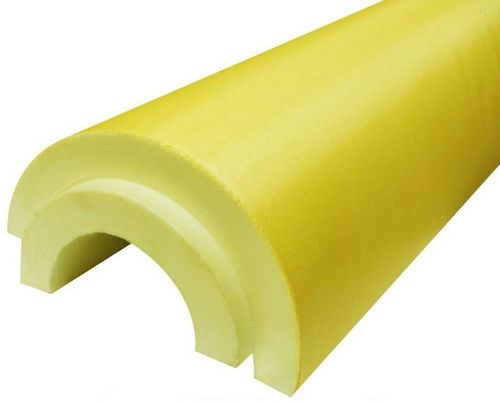

The joints should be coated with glue to reduce heat loss.
Before installing the shell, the pipes must be inspected to exclude the risk of leaks. Then the pipeline should be cleaned from traces of corrosion and primed twice.
Insulation segments should be installed with an offset of the longitudinal seams by 5-10 cm. For the insulation quality to be higher, the joints should be glued with foil or ordinary tape.
Having closed the pipeline with a protective casing, the insulation should be fixed with clamps, wire or steel tape. Then, on top of the shell, if there is no factory protective coating, roofing material, fiberglass or roofing paper are wrapped. The protection is also secured with plastic or metal clamps. The joints are coated with glue to reduce heat loss.
Together, in an 8-hour working day, you can insulate up to 150 m of the pipeline.
Installation nuances
First of all, when installing the shell, you need to determine the diameter of the pipeline - in order to be able to select the appropriate shell diameter.
If it is larger than that of the pipe, the insulation will hang on it. If it is larger, the insulation will have gaps: the shell segments simply will not converge.
To fasten the segments (we will consider this particular option, and not the whole shell - it is the most relevant), the following can be used:
- Wire - in this case, the thermal insulation put on is wrapped around it. Glue - joints (both longitudinal and transverse) are lubricated and glued. Groove - halves are connected with a latch. Neighboring segments - can be connected either with a snap or with glue.
The first option is good because it allows you to get a detachable connection: if necessary, you can simply unwind the wire, get a "bare" pipeline, and after completing the inspection (or work), put the insulation back.
The glued segments will only have to be cut. However, they can then be glued together, however, the connection quality will already be significantly lower. And every extra gap is a cold bridge.
The groove connection is suitable where there are no difficult conditions, and there is no need for the most sealed structure. The same is with the adhesive tape: it allows you to reliably fasten the heat-insulating segments, eliminating the gap, can be easily and quickly removed, allowing you to dismantle the casing, but it will not withstand difficult conditions.
Scope of application
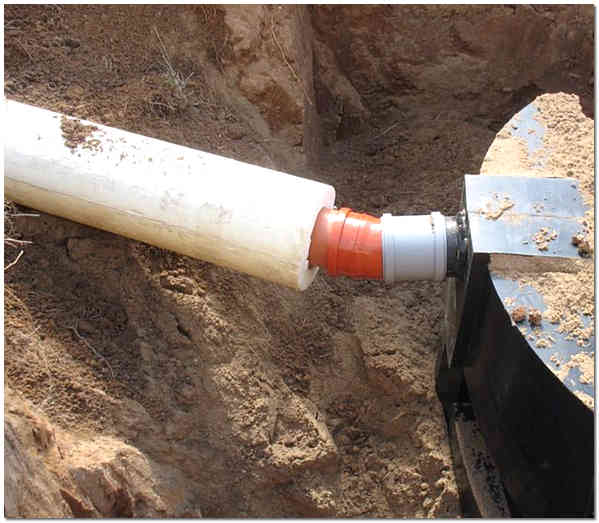

Insulation of sewer and water pipes reduces the risk of plastic rupture in winter
A shell for insulating pipes made of polyurethane foam or other material is used to maintain a constant temperature of the medium circulating inside the pipeline, to protect people from burns at high or low pipe temperatures. This material is used for insulation:
- sewer pipes;
- cooling lines;
- hot and cold water supply networks;
- chemical synthesis systems;
- pipelines in the oil and gas industry.
The high speed and ease of installation distinguish the shell from the insulation materials of a different form factor. Due to the high efficiency of insulation, environmental friendliness, ease of use, the shell for pipe insulation is popular in the field of public and private construction, industry.
What types of shells are produced
This insulation is available with or without protective lining.
It is advisable to use these insulating structures without additional coating either indoors, or as a lower layer of the insulating "pie". In other cases, the type of lining is selected depending on the environment in which the pipeline will be used.
Thus, a fiberglass coating is a very reliable protection against ultraviolet rays, therefore it is advisable to use it for thermal insulation of communications passing through the air (outdoors). Glassine is only slightly inferior to fiberglass in terms of its protective properties.
Armofol is used to insulate highways operated under conditions of significant temperature drops - this is reinforced aluminum foil.
The galvanized coating acts as an ultraviolet and anti-vandal protection, but at the same time it is a more budgetary option than fiberglass.


Shell 110 mm
For sewer pipes with a diameter of 100 mm, it is most effective to use shells. It can be mounted by hand; this does not require the installation of special trays and boxes.
How to insulate:
- First you need to choose a material for insulation and calculate the required amount. For the shell, this is usually the length of the elements that need thermal insulation.
- If the choice fell on the shell, the diameter of the pipe should also be taken into account. Usually, if it is 100 mm, a 110 mm insulation is selected.
- Installation is very simple. The two parts are put on with an overlap of 10-20 cm on the sewer pipe.
- The joints between the parts of the insulation are fixed with tape.
All fittings - tees, elbows and other elements - also need high-quality insulation. To do this, you can use shaped shells or cut a special shape with a hacksaw.
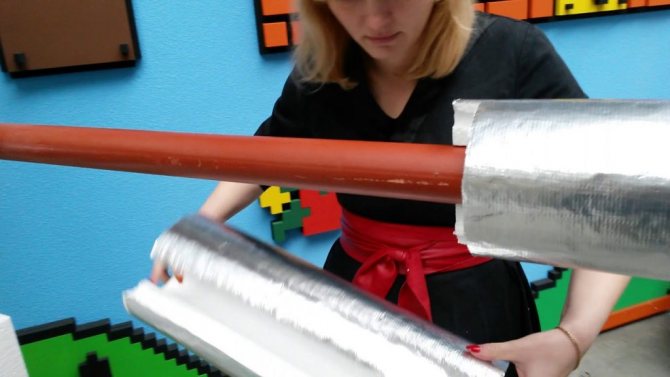

Styrofoam shell can be easily slipped onto the pipe
Foil or any other material can be used for insulation.
When choosing a heater in a store, you can ask for a sample of it to make sure of its quality. It should not deform when stretched. If it shines through when it is brought up to a switched on lamp, it means that the quality of thermal insulation leaves much to be desired.
